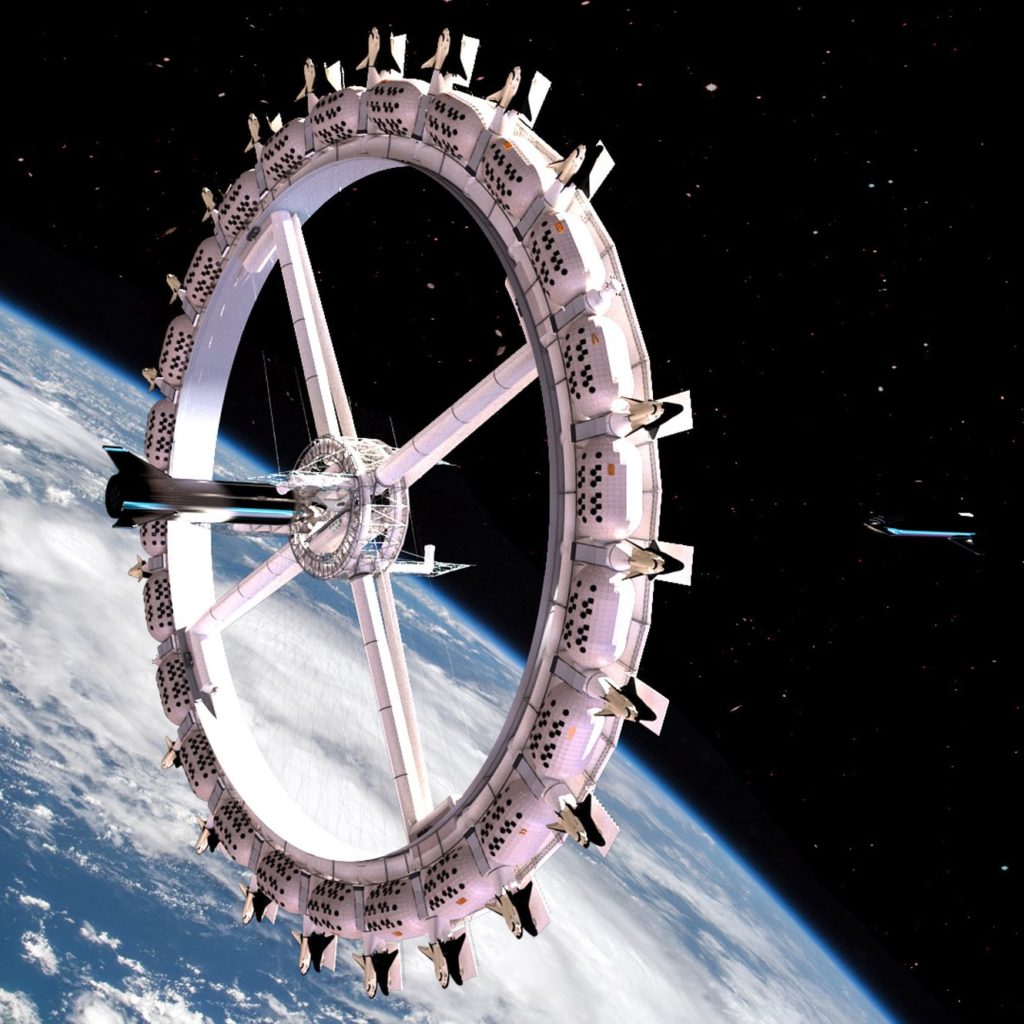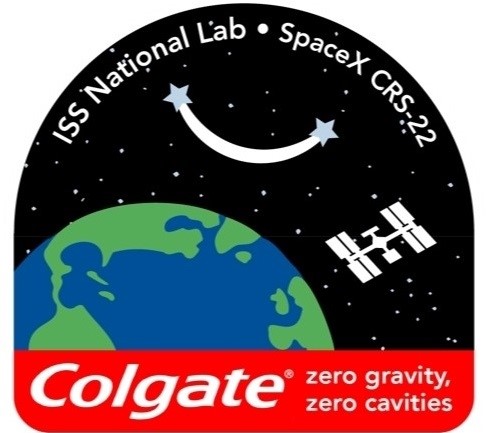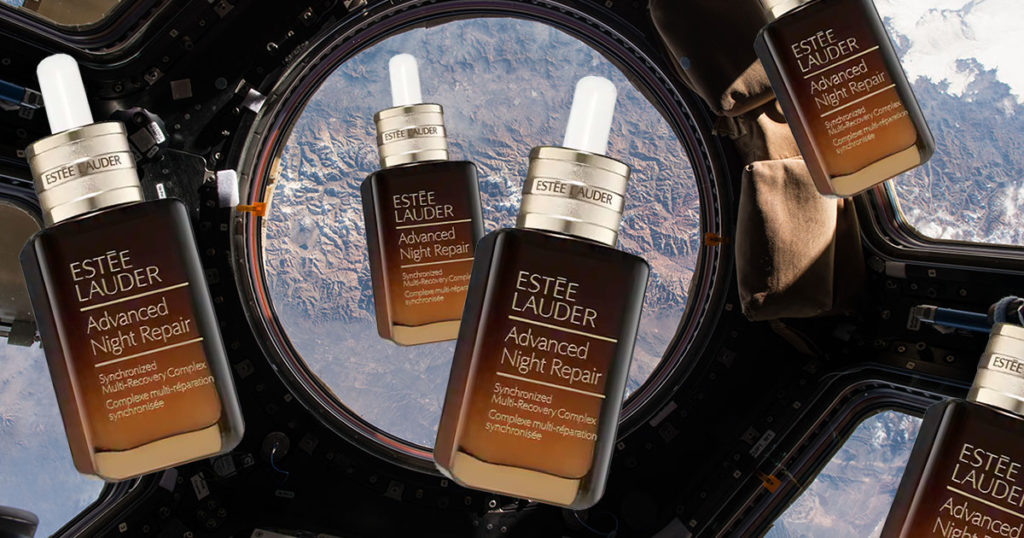Cosmic Beauty: Are we there yet?
Share

The United States and the Soviet Union were in a space race with one another over the 20th Century, from Sputnik’s launch in 1957 to Neil Armstrong stepping on the moon in 1969. Fast-forwarding 52 years there’s a new space race, except it’s amongst high-profile billionaires fulfilling their childhood fantasies.
In case you’ve been in a black hole with no internet access lately, Richard Branson blasted into space on July 11th on a rocket made by his company Virgin Galactic and on July 20th, Jeff Bezos did the same on a rocket made by his company Blue Origin.
John Blincow and Elon Musk are shooting for the moon by opening up a space hotel The Voyager Station in 2027, pioneering commercial space tourism that will host 280 (rich) guests and 112 crew members. With this on the horizon, future guests may ask themselves – But wait, what will I pack in my makeup bag for my #spaceselfies?

The Effects of Outer Space on Skin
In all sirius-ness, cosmetic companies and their scientists have many uncharted territories to think through while developing products that won’t be, ahem, launching on Earth, such as the environmental differences and how it affects their body. Some of the major environmental differences in outer space compared to Earth are the 1) Atmosphere, as it’s a vacuum; 2) Radiation, as there’s a high level of dangerous particles; and 3) Gravity, as there is weightlessness.
Tourists traveling to outer space shouldn’t expect to have that vacay glow – Space travel really does take a toll on human skin! NASA has conducted many studies showing that extended space residency can result in excessive dryness, accelerated skin aging, decreased elasticity, epidermal thinning, loss of collagen, and even a decrease in cellular regeneration.
Travelers could also experience ‘puffy face syndrome’, which is very common amongst astronauts. The human body is mostly made up of liquids. In outer space where there is zero gravity, the liquids have the propensity to go towards the face, giving it a puffy appearance.
Taking these into consideration, cosmetic and personal hygiene products that are designed to be used on Earth likely won’t have the same efficacy as they will in outer space. So how is the cosmetic industry currently approaching this?
Current Responses from Cosmetic | Personal Care Industry
Colgate-Palmolive: In 2021, they teamed up with NASA and researchers from the University of Nevada Las Vegas College (UNLV) of Engineering and School of Dental Medicine to determine if their oral health products are efficacious against periodontal diseases and cavities in outer space. On June 3, a rocket carrying saliva and oral bacteria collected from 30 UNLV dental clinic patients in 25 kits designed by UNVL engineers blasted off to the International Space Station. The kits contain 3D-printed battery-powered microfluid pump devices and will be used to test the efficacy of Colgate’s oral health products and are undergoing analysis in UNLV labs in July. The tagline for the initiative is none other than ‘Zero gravity, Zero cavities‘.

Estée Lauder: In 2020, they launched 10 skincare serum bottles of Estée Lauder Advanced Night Repair Face serum into outer space for promotional photo and video shoots. The photoshoot is a part of NASA’s efforts to promote business opportunities on the International Space Station, which the organization is calling a low-Earth orbit economy. In addition, NASA astronauts were to film the usage of the serum which will be potentially used in future ad campaigns or other promotional materials.
Although advertisements in space are not a new thing (as also seen from Coca-cola, Pizza hut, Pepsi, Cup Noodle, and Tesla), NASA’s renewed efforts in bringing the private partnership to support space exploration signifies the shift in momentum towards commercialization of space ventures.

REJUVEL: As a longer-term technology application, NASA designed a bioreactor in order to initially study the effects of long-term microgravity on human tissues in simulated reduced gravity conditions. It is used to cultivate different animal and human cells in these conditions, resulting in three-dimensional tissues that closely resemble those in the body. It also includes a form of the pulsed electromagnetic field to the exterior of the bioreactor, resulting in an exponential growth of tissue cells and the production of unique biomolecules.
For its application in the beauty arena, bioreactor technology can produce cosmetic ingredients (a.k.a supernatant or cell culture fluid) such as polypeptides and growth factors from human epidermal fibroblasts. NASA licensed this technology to REJUVEL products to produce Space Certified products that “are actually capable of jumpstarting the underlying biological processes in order to enhance the skin’s resiliency, improving moisture and skin tone balance at the source by promoting fibroblasts to produce new collagen, elastic fibers, and glycoproteins.”

So What Lies Ahead for the Future of Cosmic Beauty?
Although there are not yet clear-cut answers for this yet, the sky is not the limit in terms of exploration. Cosmetic companies and the scientist that work for them must remember that the products that they design for humans on Earth may not display the same efficacy and performance in outer space simply because the environmental and biological parameters are vastly different.
Luckily for cosmetic scientists, the tried-and-true scientific method remains the same in approaching this. On top of designing efficacious products, some questions that they may consider in the early stages product development while creating and testing hypotheses include:
With resources such as water being limited in outer space, how can we give them the same personal care experience without disrupting their routines?
Since the concept of time is different, how will cosmetics and personal care products fit into a routine?
How will these cosmetics be regulated?
Since the 5 senses (smell, touch, sight, sound, and taste) are different in zero gravity, how can we make aesthetically pleasing cosmetics?
What product stability scenarios should we consider and how will we test them?
With limited space, what types of packaging should we consider?
The list of questions in the exploration phases really go to infinity and beyond. We may expect a third space race in the future, except it would involve cosmetic corporations trying to get their products in The Voyager Station swag bags. As we break into this category, it’s important for cosmetic scientists to lead these initiatives so that the product integrity isn’t diluted by any gimmick concept or in-the-moment ‘trendy’ ingredient. After all, all of these initial small steps could be a giant leap for the future in cosmic beauty.
References:
1. Lei XH, Ning LN, Cao YJ, Liu S, Zhang SB, Qiu ZF, Hu HM, Zhang HS, Liu S, Duan EK. NASA-approved rotary bioreactor enhances proliferation of human epidermal stem cells and supports formation of 3D epidermis-like structure. PLoS One. 2011;6(11):e26603. [Pubmed]
2. Growth stimulation of biological cells and tissue by electromagnetic fields and uses thereof. Patent No. 6,485,963
3. www.nasa.gov “From Cosmic to Cosmetics: NASA Bioreactor Technology Finds New Purpose Developing Beauty Products” Accessed May 6, 2021
4. www.nasa.gov “Your face is like the moon”. Accessed May 6, 2021
5. www.space.com “As Seen on TV: These Commercials Were Filmed in Space!” Accessed May 6, 2021
6. UNVL Engineering and Dental Researchers Partner with NASA, Colgate Accessed July 14, 2021
7. Cover image credit – mikhail_nilov
If you enjoyed our content, please share, comment, like, and follow us on your favorite platforms!
.
.

